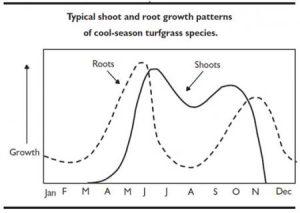What is Clover?
Today is the first day of Spring! As the days get longer and the soil begins to warm, the turf grass will start to come out of winter dormancy and so the race to establish a dense stand of turf begins. In the spring, the first competitor to show is clover. Weeds tell a story about what is going on in the soil. So, to understand what to do about them let’s take a look at why they’re there…
Ideal Conditions for Clover to Thrive
The short answer to why there is clover is that there’s a lack of nitrogen being supplied to the turf grass. The presence of large areas of clover in a lawn or athletic field indicates the area is not receiving adequate fertilization and more nitrogen is needed.
Clover is a cool-season perennial that spreads by seed and creeping branched stems. It is more likely to establish itself during a cool, wet spring before the turf grass starts growing. Some consider clover to be a weed. However, clover can actually be a beneficial plant because of its ability to obtain nitrogen from the atmosphere and ‘fix’ it in nodules on its roots.
Clover seed will germinate in soil temperatures as low as 45° while the optimum growth temperatures for cool season turf grass is: roots 50° – 65°; seed in the 60° – 65° range; and shoots 60° – 75°. It does well when there is not a lot of nitrogen available in the soil. Additionally, when turf grass is thin, light can reach the soil surface and encourage the clover to germinate. Because clover seeds have a hard coat they can survive in the soil for long periods of time until conditions are right to encourage their germination.

This graph from UMASS shows the typical shoot and root growth patterns in the Northeast. In a typical season (in a perfect world) over seeding should occur prior to May 15th and between August 15th and September 15th. Unfortunately, we have repeatedly had very difficult springs back-to-back that have not been conducive to the establishment of lush, vigorous turf grass coming out of winter dormancy. In contrast, our spring season has consistently favored the further establishment of clover.
Is Clover All That Bad?
It should be recognized that clover is a beneficial plant and used to actually be included in grass seed blends. Clover is a legume that can fix free nitrogen from the atmosphere and share it with turf grass. So, the presence of clover can actually be a good thing for emerging turf grass. That said, there are improvements that can be made to aid in the establishment of our desirable turf grasses…
What to Do
We recognize that, while there are benefits to this plant, it’s not everyone’s favorite thing to see clover in your lawn. So, if you would like to take preventive measures while treating your lawn organically, take the following into consideration:
- Turf Coverage – have an aggressive over-seeding program – minimum twice a year with high quality grass seed suitable for the site. This will help to establish a denser stand of turf.
- Fertility – assess your fertility program. Typical target is 2lbs/1,000sf in a season. This tends to be a middle of the road approach. If this is not meeting expectations, add a 4th All-Natural Organic Fertilizer application or change to a higher “N” product – possibly the 7-0-2+ or 8-0-6.
- Organic Matter – continued focus on improving levels of organic matter is important to help buffer the soil conditions. Best done through top-dressing and raising the height of cut (HOC). The higher the HOC the deeper the roots, that add to the level of OM as they die and slough off.
- Maintenance Height of Cut –It is important to note that with a higher height of cut the turf grass will exhibit improved stress resistance, appearance and additions to organic matter. Following correct mowing protocol throughout the growing season is a critical cultural practice that can’t be overstated.
- Contact PJC! — we make product recommendations based off soil tests to ensure your soil is getting what it needs to grow healthy turf.
We’ve said it before and we’ll say it again (and again)…Work in the Spring and Fall to establish a dense stand of turf that will crowd out weeds. Reach out for info on how we can help you implement organic turf care successfully!








